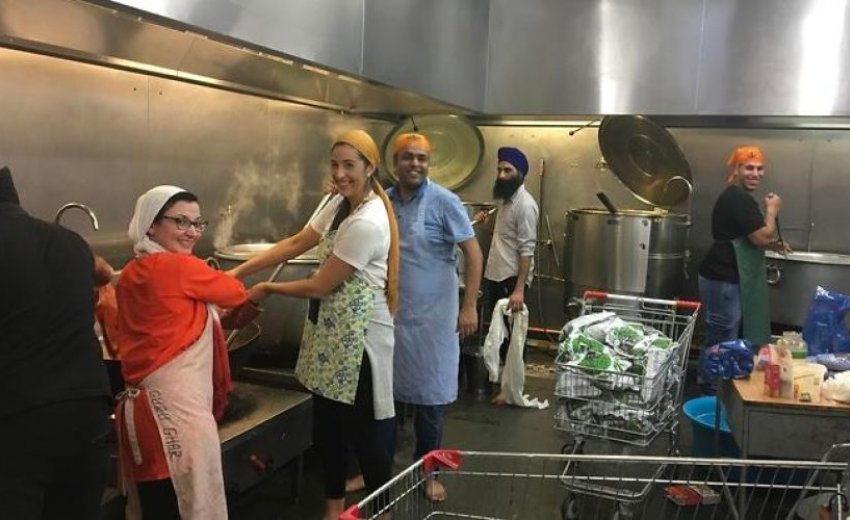For years now, the Sikh community has been religiously living by the ethos of Sikhism that propagates the idea of ‘vand chhako’, or sharing and consuming meals together. Almost every gurudwara has a community kitchen where the devotees cook food and serve it with utmost love. During one such day, the former contestants of MasterChef Australia came together to prepare a wholesome Sunday dinner at the Craigieburn gurudwara in Melbourne.
Different cultures coming together for ‘Langar Sewa’
Sikhs, and followers of Sikhism collectively cook langar i.e the communal meal at the community kitchen. They help the appointed gurudwara members, commonly referred to as sewadars, with food preparation. In 2019, former contestants of MasterChef Australia, Monica Mignone, Sandeep Pandit, and Waleed Rasheed came together to cook langar at the Sri Guru Singh Sabha Gurdwara, in Melbourne’s northern suburb of Craigieburn.
It was one of the humblest displays of Australia’s multiculturalism, where a Hindu from India, a Muslim from Egypt, and a Christian who’s half Australian, half Italian, volunteered to cook for a largely Sikh congregation in their place of worship. The group, exhibiting a kaleidoscope of cultures and beliefs, prepared a delicious dinner for the gurdwara’s Sangat (devotees).
One of the contestants, Sandeep Pandit, who originally hails from the Jammu and Kashmir region of India, said, “When I asked my friends from MasterChef if they’d like to join me in the gurdwara, I was pleasantly surprised to see so many of them say yes, even though they were from a non-Indian religious and cultural background.”
"This is the unifying power of food,” he added.
Collective cooking that brings out flavors of faith
From 3 pm until 7 pm, the three celebrity chefs and the gurdwara's army of about a dozen volunteers worked in the well-equipped kitchen of the temple to prepare dinner for 1,000 people. They sorted the ingredients, cut vegetables, and prepared some of the most-loved vegetarian North-Indian dishes - rajma (red kidney beans), matar-paneer (peas and cottage cheese), kheer (rice and milk pudding with dry fruit), raita (spiced yogurt with chopped vegetables), rice and over 6,000 parshadas (flatbread as they are called in gurdwaras) for the Sangat.
As the news of the celebrity chefs cooking the meal spread, the number of people who came in for dinner, including the fans of the MasterChef contestants, went as high as 3,000. With more people coming to the gurdwara for a scrumptious meal, even the seemingly huge quantity of food was quickly consumed. Eventually, the sewadars had to cook a large vessel of pulao (rice cooked with vegetables in a spicy broth), to satiate those who couldn’t savor the delicacies prepared by the chefs. It is a clear reflection of how Sikhs ensure that every devotee or visitor who comes to gurudwara never goes away empty stomach. Until everyone is served, the food keeps on coming in. So, people can enjoy the meal, and eat to their heart’s content.
On a similar line, a regular visitor of the Melbourne gurudwara said, "But you know, nobody ever goes hungry in a gurdwara. I’m even planning to pack some langar and take it home,”
While MasterChef Australia is a challenging and intimidating food-making competition, the chefs recounted that they weren’t aware how volunteering to cook langar at a gurudwara would be. However, it was a one-of-its-kind experience for them. One of the Egyptian-origin contestants, Waleed Rasheed, revealed that he gave kheer a distinct flavor by adding walnuts and cinnamon, as opposed to Indian kheer, which comprises cardamoms and almonds.
On the occasion, G.S. Pangly, president of the Sri Guru Singh Sabha Gurdwara, praised the initiative by the group. He said, “Gurdwaras are open to people from all religions. Everyone is welcome to eat or cook here. It was a matter of great pride for us that MasterChef Australia’s contestants graced our kitchen. We usually serve around 1,000 devotees on Sunday.”
"But when people came to know about them, the numbers multiplied. But there’s never any dearth of food here,” he added. This is exactly what the tradition of langar entails - no one goes hungry, and there is always food for everyone.
How langar or the free community meal started
Guru Nanak Dev Ji, the founder of Sikhism, conceptualized the idea of langar in 1481. He did this to promote the ideal that all people should be treated equally. Later on, it became popular among the community as, "Guru Ka Langar”. Thereon, everyone was invited into the communal kitchen of the Guru, and the food served there was always free. This was done to ensure that everyone, regardless of race, caste, financial class, religious affiliation, or gender, maintained harmony and respect for each other. It also challenged the largely followed hierarchical historical structures and social prejudices during the time.
Since then, langar has become an integral part of the Sikh culture. Today, almost every gurudwara has a separate area for the kitchen and langar hall. In the langar hall, everyone sits together and enjoys their meal. After every few minutes, the volunteers take rounds of the langar hall with containers full of food, serving ladles full of simmering hot all-vegetarian delish dishes.
The langar tradition has come a long way. From cultivating connection with people during times of peace and recuperating during critical times, ‘Guru Ka Langar’ has filled the hearts and stomachs of thousands across the globe. It is a symbol of humanity, togetherness, and cultural harmony. With time and awareness, Sikhs from across the world have been tending to those in need, whether because of natural disasters or hunger due to poverty, with meals that are prepared with ever-growing faith.
*Based on an article by Ruchika Talwar, Published on July 9, 2019, in SBS Punjabi
